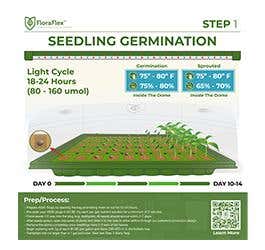Breeding new cannabis varieties is an exciting and rewarding endeavor for cannabis enthusiasts and cultivators alike. By combining different genetic traits, breeders can develop unique strains with desirable characteristics.
1. Phenotype Selection
Phenotype selection is a traditional breeding method that involves visually assessing cannabis plants for specific traits. Breeders carefully observe plants' physical characteristics, such as plant structure, leaf shape, flower size, and resin production. By selecting plants with the desired phenotype, breeders can create offspring that inherit those traits.
2. Genotype Selection
Genotype selection focuses on the genetic composition of cannabis plants rather than their physical appearance. Breeders analyze the plants' DNA through genetic testing to identify specific genes associated with desired traits, such as high cannabinoid content, terpene profiles, or disease resistance. Genotype selection allows breeders to make informed decisions based on the plants' genetic potential.
3. Crossbreeding
Crossbreeding is a fundamental breeding method that involves mating two different cannabis plants to create offspring with a combination of their genetic traits. By carefully selecting parent plants with complementary traits, breeders can create hybrid strains that exhibit the desired characteristics from both parents. Crossbreeding allows for the introduction of new traits and genetic diversity.
4. Backcrossing
Backcrossing is a technique used to stabilize specific traits in a strain. It involves crossing a hybrid strain with one of its parent strains. The resulting offspring, known as backcrosses, inherit more genetic material from the parent strain, reinforcing the desired traits. Backcrossing helps maintain the desired characteristics while eliminating unwanted traits.
5. Selfing
Selfing, or self-pollination, is a technique where breeders intentionally pollinate a female plant with its own pollen. This method allows breeders to create offspring that are genetically similar to the parent plant. Selfing is commonly used to stabilize and preserve specific traits within a strain.
6. Cloning
Cloning is a method where cuttings, or clones, are taken from a selected mother plant and grown to produce genetically identical offspring. Cloning ensures that the genetic traits of the mother plant are replicated in the clones. This method is useful for preserving and perpetuating desirable traits, as well as maintaining genetic consistency within a strain.
7. Tissue Culture
Tissue culture, also known as micropropagation, involves growing cannabis plants from small tissue samples in a laboratory setting. This technique allows breeders to rapidly propagate large numbers of plants with identical genetic characteristics. Tissue culture helps maintain genetic purity, reduces the risk of pests and diseases, and facilitates the preservation of valuable genetic material.
8. Hybridization
Hybridization is a breeding method that involves crossing two genetically distinct cannabis strains to create hybrid offspring. The goal of hybridization is to combine the best traits from each parent strain, such as high potency, unique flavors, or specific growth characteristics. Hybridization can lead to the development of novel and desirable cannabis varieties.
9. Polyploidy Induction
Polyploidy induction is a technique used to create plants with more than the usual two sets of chromosomes. By exposing cannabis plants to certain chemicals or treatments, breeders can induce polyploidy, resulting in offspring with increased genetic material. Polyploidy induction can lead to changes in plant size, vigor, and potential trait variations.
10. Marker-Assisted Selection
Marker-assisted selection is a modern breeding technique that involves the use of genetic markers to select plants with specific traits. Breeders analyze the plants' DNA to identify genetic markers associated with desired characteristics.
















